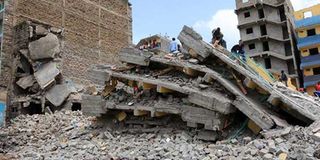Let State end trend of collapsing buildings

The remains of a building that collapsed in Huruma in 2016. We see building sites still abuzz even after the famous ‘X’ has been painted across its gates because the NCA can, for the most part, only bark but not bite. PHOTO | FILE | NATION MEDIA GROUP
What you need to know:
- For most Kenyans, news of a building collapsing has become a little too common to register any shock.
- The most recent devastating case was in April 2016, when a building crumbled in Huruma, killing 52 people.
- Demolition of unsafe buildings by the NBI should be expedited and the agency adequately funded to carry out its mandate.
About a month ago, before dawn on Sunday, June 3, a five-storey building in Huruma, Nairobi, collapsed, leaving at least three people dead and three others hospitalised in critical condition.
For most Kenyans, however, news of a building collapsing has become a little too common to register any shock.
In the past 20 years alone, at least a similar number of buildings have collapsed across the country, killing some 200 people and injuring even more and causing loss of property in the hundreds of millions of shillings.
HURUMA
The most recent devastating case was in April 2016, when a building crumbled in Huruma, killing 52 people.
Last year, the National Building Inspectorate (NBI) — whose mandate is to audit buildings for conformity with land registration, planning, zoning, building standards and structural soundness — audited 4,879 buildings in high-risk towns countrywide. Of these, 826 were found to be unsafe and structurally unsound.
At least 38 buildings have since been demolished, excluding those that collapsed.
Bad structural design, faulty construction, substandard materials and poor workmanship are among the most common reasons for the collapsing of buildings.
CONSTRUCTION PLAYERS
The success of a construction project depends on a chain of players: Developer, qualified professionals, county governments and State agencies like the National Environment Management Authority (Nema) and the National Construction Authority (NCA). This chain is as strong as its weakest link.
Impunity is the common thread that cuts across all the weak links — from the greedy developer to unqualified persons purporting to be professionals and cor-rupt county and national government officials to the apathetic citizenry. To top it all up is a weak judicial system that has not held a person criminally liable since the first building collapsed in the year 1996!
The government should protect the citizenry from the whims of errant developers.
DESPERATE FOR HOUSING
In the case of Nairobi, residents are desperate for decent, affordable housing and it is in this desperation that greedy developers thrive. Around 60 per cent of the city’s population lives in informal settlements and slums.
County governments have the duty to ensure buildings being constructed are approved and meet all the minimum requirements. Unfortunately, statistics show that up to 70 per cent of constructions in Nairobi do not have approval.
The counties should also ease compliance to the law. While digitisation of the county building approvals is welcome, users of the system still complain of bottle-necks and, for the most part, it is still a lengthy process not devoid of the “human interface” as had been envisioned. The high fees are also a deterrent.
The NCA should have an in-house enforcement arm similar to the NTSA’s. We see building sites still abuzz even after the famous ‘X’ has been painted across its gates because the NCA can, for the most part, only bark but not bite.
Demolition of unsafe buildings by the NBI should be expedited and the agency adequately funded to carry out its mandate.
Or are we going to sit around waiting for the remaining 788 shaky buildings to collapse and kill more?
Ms Miloyo is the president of the Architectural Association of Kenya (AAK). [email protected].





